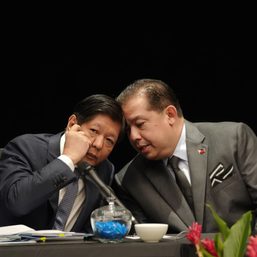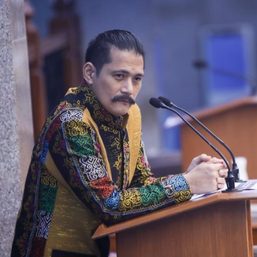SUMMARY
This is AI generated summarization, which may have errors. For context, always refer to the full article.
![[ANALYSIS] The art of free society](https://www.rappler.com/tachyon/2023/07/tl-art-of-free-society.png)
The title of this piece is derived from the work on symbolism of the English mathematician and philosopher Alfred North Whitehead.
Whitehead wrote: “It is the first step in sociological wisdom to recognize that the major advances in civilization are processes which all but wreck the societies in which they occur – like unto an arrow in the hand of a child. The art of free society consists first in the maintenance of the symbolic code; and secondly in the fearlessness of revision, to secure that the code serves those purposes which satisfy an enlightened reason. Those societies which cannot combine reverence to their symbols with freedom of revision, must ultimately decay either from anarchy, or from the slow atrophy of a life stifled by useless shadows.”
Several proposals are pending in Congress for the amendment or revision of the Constitution. Some relate to its economic provisions, others to such matters as the form of government and, as almost always, whenever there is a cha-cha, to the removal of term limits or the extension of terms of office of elective officials.
The reaction of two key members of Congress to these proposals presents interesting studies of attitudes toward change of the Constitution as the symbolic code. When told that the Senate was cool to proposals to amend the Constitution’s economic provisions and advised to seek the support of the President, Senator Robinhood Padilla said, “I will never do that. If I ask for the President’s blessings, that means we are a subordinate of the executive.”
That is the art of free society, a person’s determination, regardless of political consequences, to seek the amendment of the Constitution because of what he perceives is a necessity for change.
Representative Richard Gomez was also for charter change, but his reason was different. The Constitution, he said, was already old. Like an old car, it must be changed. (“Parang lumang kotse iyan, eh. Ang lumang kotse kailangan inaayos na.”) That is not the art of free society. The change must be for “purposes which satisfy an enlightened reason.” For that matter, there are people who think that because the Constitution has lasted, it is good and must not be amended. I remember a member of the Constitutional Commission, which framed the present Constitution, saying this during a Senate committee hearing on charter change.
Taking the Constitution seriously and changing it whenever necessary without changing its essential nature is what the Art of Free Society is about.
The Constitution is our symbolic code.
The ideals and principles stated in its Preamble, the basic rights and duties enshrined in its Bill of Rights, and the system of government established by it must be taught to the people at an early age, in the primary schools and the high schools, so that the Constitution will live in their action and their being. The Constitution is also our social contract, as the Supreme Court said. It is similar to what two or more persons make when they enter into a contract of partnership. It is similar to what two persons make when they enter into a contract of marriage. It is binding on us the people and imposes on us certain obligations. If the Constitution has not worked out the way we expect it to work, perhaps it is because “We, the sovereign Filipino people” have not lived up to our obligations under it.
Balancing act
However, reverence of the Constitution must not be allowed to degenerate into idolatry. Times change and with them the Constitution must change consistent with its essential nature. As Chief Justice Marshall said, the American Constitution was intended by its framers “to endure for ages to come and consequently to be adapted to the various crises of human affairs.”
How well have we practiced the art of free society in our country?
At the threshold of independence, in 1947, we amended the Constitution, to grant equal rights for 28 years to Americans and their corporations in the exploration, exploitation, and development of our natural resources and the operation of public utilities. We did this so that our goods could continue to enjoy free trade in the American market after independence, what with our economy destroyed by the last war. The grant was for 28 years, or until 1975, but even before that year, we endeavored and succeeded in getting some adjustments which enabled us to maintain the Constitution as our symbolic code.
In 1969 we revised the Constitution in response to urgent social and economic changes. Unfortunately, lawless elements took advantage of the occasion, justifying the establishment of an authoritarian regime. Thanks to the resilience of our country, however, our society eventually redeemed itself and in no time the constitutional order was restored with the present Constitution.
We have been able to do this because we have the means, formal and informal,for adapting the Constitution to change without changing its essential nature change. The formal means for doing this are to be found in Art. XVII, the provisions of which are intended to act as safety valves to prevent violent expressions of popular will or revolutions. Unfortunately, Sec. 1 of this Article fails to provide whether, when acting as a constituent assembly, the two houses of Congress must sit jointly or separately, and, if they sit jointly, whether they must vote as one assembly or in two divisions as in the 1935 Constitution. This problem has arisen, because the provision in question was originally intended for a unicameral National Assembly. But the Constitutional Commission later decided to have a bicameral Congress. Several provisions of the draft constitution were revised to reflect this decision, but the correction of Art. XVII, Sec. 1 was overlooked.
Thus, in the following cases, it was provided that the two houses of Congress must meet jointly but vote separately:
- To declare the existence of a “state of war.”
- To canvass the votes for President and Vice President and proclaim the winners, and, in case of tie, to break the tie.
- To revoke the President’s proclamation of martial law or suspension of the privilege of habeas corpus, or to extend the period of proclamation.
- To confirm the President’s nomination of a Vice President whenever a vacancy occurs in the office during the term of the Vice President.
- To decide a dispute between the President and his cabinet, if, after declaring himself unable to discharge the duties of his office, he subsequently claims to be fit to resume his office, but a majority of his cabinet disagrees.
If the two houses of Congress are required to meet in joint session but to vote separately in performing these non-legislative functions, with more reason must they be required to do the same in performing their function under the Amendment Clause. To read the Amendment Clause as simply requiring Congress, when acting as a constituent assembly, to require one house to propose amendments or revisions and then to send its proposals to the other house for concurrence and, if they have some disagreements, to thresh them out in a conference committee, is to recognize no distinction between lawmaking and amending or revising the fundamental law.
On the hand, the informal means of changing the Constitution are to be found in the power of judicial review of the Supreme Court and in the power of executive officials to execute the Constitution and the laws.
The Supreme Court functions as a “continuing constitutional convention,” treating the Constitution as a “living organism,” capable of adaptation and change. Its interpretation of what the Constitution means constitutes part of the law of the land. (Next: Constitution and the duty of every generation) – Rappler.com
This is an excerpt from a speech of retired Justice Mendoza at the Magister Lecture Series, UP College of Law, on June 30, 2023.
Add a comment
How does this make you feel?
![[ANALYSIS] The Constitution and the duty of every generation](https://www.rappler.com/tachyon/2023/07/constitution-duty-generation-july-4-2023.jpg?fit=449%2C449)



![[Vantage Point] Philippine economic reforms run into headwinds](https://www.rappler.com/tachyon/2024/05/ph-economic-headwind-may-2024.jpg?resize=257%2C257&crop_strategy=attention)
![[In This Economy] A counter-rejoinder in the economic charter change debate](https://www.rappler.com/tachyon/2024/04/TL-counter-rejoinder-apr-20-2024.jpg?resize=257%2C257&crop=267px%2C0px%2C720px%2C720px)






![[EDITORIAL] Bakit hindi mahuli-huli si Apollo Quiboloy?](https://www.rappler.com/tachyon/2024/04/animated-quiboloy-investigation-april-2024-carousel-edit.jpg?resize=257%2C257&crop_strategy=attention)

![[Vantage Point] Beware of false prophets: A cautionary examination](https://www.rappler.com/tachyon/2024/03/tl-false-prophet.jpg?resize=257%2C257&crop=272px%2C0px%2C720px%2C720px)
![[EDITORIAL] Kalaban mo ang mga senador na protektor ni Quiboloy](https://www.rappler.com/tachyon/2024/03/animated-quiboloy-kojc-senate-carousel.jpg?resize=257%2C257&crop=365px%2C0px%2C720px%2C720px)
There are no comments yet. Add your comment to start the conversation.